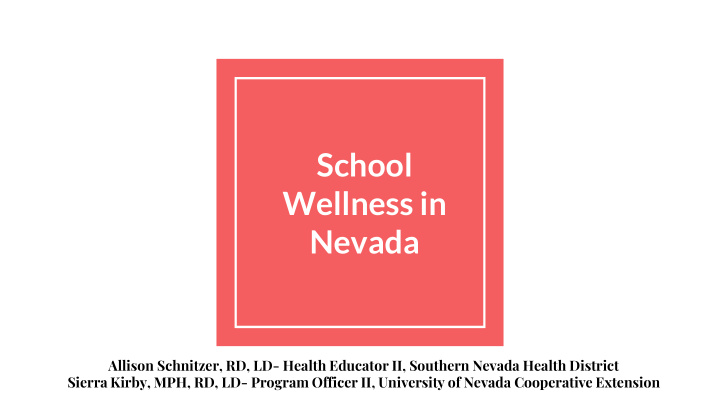



School Wellness in Nevada Allison Schnitzer, RD, LD- Health Educator II, Southern Nevada Health District Sierra Kirby, MPH, RD, LD- Program Officer II, University of Nevada Cooperative Extension
Nevada Schools at a Glance 17 districts, 610 schools, 442,631 students, 59.67% FRL Clark: 348 schools, 327,501 students, 64.26% FRL ● Washoe: 109 schools, 68,002 students, 45.57% FRL ● 15 districts: 153 schools, 50,634 students. 47.71% FRL avg ● State Public Charter School Authority 46 schools, 33,259 students, 32.69% FRL ●
Nevada Childhood Health Indicators Nevada: 8th in the nation for the percentage of ● students who are overweight at 14.3% and 19th in the nation for those who are obese at 14% (a decrease from 15% and increase from 12.2%, respectively, in 2017). Inactivity increased from 49% in 2015 to 53.6% in ● 2017. 7.5% of youth reported not consistently eating ● fruit (U.S. average = 5.6%)
Nevada State School Wellness Policy (SWP) Healthy, Hunger-Free Kids Act of 2010 (HHFKA) ● Federal rule requires all local educational agencies participating ○ in NSLP and/or NSBP to meet local school wellness policy requirements Established framework for content of local school wellness ○ policies Requires periodic assessment of compliance and reporting ○ Local School Wellness Structure: ● Statewide SWP (meets federal minimum requirements) ○ County School District SWP (meets federal and state ○ requirements) School District Wellness Coordinator and/or School Level ○ Wellness Coordinator (required by NV SWP; CCSD R-5157 requires both)
SWP: National School Breakfast & Lunch All food served as part of NSBP/NSLP must meet ● nutrition standards in order to be a reimbursable meal NDA can penalize food service for not meeting nutrition ● standards; cannot penalize schools directly for not meeting other components of the wellness policy Reimbursable breakfast: food service must offer 4 ● components (fruit/vegetable, milk, grain, optional meat/meat alternative); students must take 3 components, one of which must be a fruit or vegetable Reimbursable lunch: food service must offer 5 ● components (fruit, vegetable, milk, grain, meat/meat alternative); students must take 3 components, one of which must be a fruit or vegetable
Nevada State SWP Continued Components of the Wellness Policy ● Marketing foods/beverages during school day ○ Smart Snacks Nutrition Standards (Calories, Sodium, Fat, Sugar) ■ Fundraising ○ Incentives/Rewards* ○ Special Occasions (holidays, birthday parties, etc.)* ○ Revenue (from sale of food) ○ Advisory Group ○ School and community stakeholders ■ Recordkeeping ○ SWP Goals ○ Nutrition promotion/education, physical activity other school-based wellness activities ■ Meal Consumption ○ 15 minute breakfast, 20 minute lunch ■ Physical Activity ○ Opportunity for 30 minutes, can’t use PA or withhold PA opportunities as punishment ■ Beverages, Caffeine, Chewing Gum ○
SPAN-ET Assessments The School Physical Activity and Nutrition Environment Tool (SPAN-ET) assesses ● school physical activity and nutrition contexts, determines school resources, readiness, and suggests appropriate improvement strategies, and measures changes resulting from policy, systems, and environment (PSE) treatments. Assesses 27 areas of interest within nutrition and physical activity categories ○ Includes assessment of the physical, situational, and policy environment ○ UNCE in partnership with local organizations has ● been conducting SPAN-ETs in Clark, Lyon, and Washoe counties Preliminary results from Clark County show ● minimal knowledge of and compliance with SWP 100% schools have fair practice (26% to <50% criteria ○ met) for their physical activity policy environment 75% schools have poor practice (<25% criteria met) for ○ their nutrition policy environment
PHN School Wellness Taskforce (S. Nevada) Vision: Clark County School District students have a healthy weight through physical activity and healthy eating at school Mission: To promote and support implementation of the Clark County School District Wellness Policy (R-5157) Goals Raise awareness of R-5157 among CCSD Administrators, ● Wellness Coordinators, PTAs/SOTs, parents and students Streamline communication with CCSD District Wellness ● Coordinator to develop and disseminate resources to CCSD school wellness coordinators Advocate for policy, systems and environmental changes ● that support overall school wellness at the local and state level
Barriers to School Wellness Implementation Incomplete/inaccurate reporting from schools ● Lack of enforcement capacity or incentives/punishments for schools ● District wellness coordinators have other large subject areas to cover ● No additional compensation for wellness coordinators at schools ● No additional funding for wellness initiatives from state/school districts ● Competitive foods from outside vendors ● Schools are reducing time for recess and PE/time to eat in order to create more ● time in the classroom (test scores determine star rating) Food waste at breakfast and lunch ●
Opportunities for Action Funding for dedicated district wellness coordinators ● Incentives for schools for high-achievement in wellness (compliance with SWP) ● Food waste diversion/food recovery program for local community ● Incentives for schools for participation in NSBP and NSLP ● Start/strengthen local produce and farm to school programs ● Legislation to require districts and charters to offer NSBP and NSLP ● Penalties for outside vendors that do not meet policy standards ●
Questions? Allison Schnitzer, RD, LD: schnitzer@SNHD.ORG ● Sierra Kirby, MPH, RD, LD: kirbys@unce.unr.edu ●
Recommend
More recommend